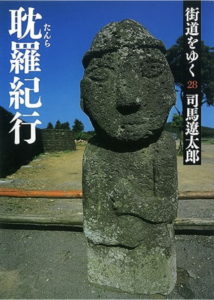Life Tips & Miscellaneous Travel and History Zen Philosophy and History Art and Sport Navigation of this blog
Summary
Travel is an act for human beings to visit new places and experience different cultures and histories. Through travel, people can actually feel historical events and people’s lives by visiting historical places and cultural heritage sites, and can gain a deeper understanding of history and broaden their own perspectives. In this section, we will discuss the historical background of the trip and the places visited based on Ryotaro Shiba’s “Kaido yuku” (On the Road) about this journey and history.

form Vol26. In the previous article, I discussed Taiwan travelogue.This trip will be to Jeju Island, Korea. In Jeju, we will visit the sacred site of Samseonghole, and then travel southward in a westerly direction around the island, stopping at Hallym Park and the site of the end of the Sambyeoljangun, who resisted Yuan rule to the end. In Seogwipo City in the southern part of the island, we will meet with local elders and drive across the foot of Mt. Halla to think about the Mongols and Mongolian horses that migrated south in search of grasslands in the 13th century. In the old port of Chaocheon, we will ponder the bureaucrats who were exiled to the island during the Yi Dynasty, a Confucian state that lasted 500 years, and conclude the trip with a long-awaited meeting with shamans and haenyeo (female divers).

Jeju Island (Jeju-do, Korea) is a volcanic island located southwest of the Korean Peninsula, between the Sea of Japan, the East China Sea, and the Yellow Sea. Together with its attached islands, it constitutes the Jeju Special Self-Governing Province of the Republic of Korea. With a population of approximately 660,000 and an area of 1,845 km2, it was formerly known as Quelpart (퀠파트) in English and other Western languages.

Until 1402, there was an independent kingdom called Tamna. After its annexation by the Goryeo Dynasty and the Rhee Dynasty, it became a place of exile, and the only population influx from the Korean peninsula was during the exile, making it a place that maintained its own culture.
The warm Tsushima Current flows around the island, making it the mildest climate in Korea, which has a continental climate with cold winters. The island has become a major tourist destination along with Seoul, the capital city of Korea.
Hallasan, which rises 1,950 m above sea level, is located at the center of the island. 1.8 million years ago, volcanic activity began, and the island was almost completely formed by shield volcanic activity, followed by monogenetic volcanic activity. More than 360 pyroclastic hills have been formed on the island and along the coast. The rocks are mainly composed of basalt. Hallasan is the highest mountain in the country and is visited by many climbers. Jeju Island is also close to Japan, with the nearest island, the Goto Islands in Nagasaki Prefecture, about 180 km away.
The first stop on the road trip to Jeju Island is the Samseonggap, a sacred place in the mythology of the founding of the nation, called “Samseong Mythology”.

On the still uninhabited ancient island of Jeju, there were three godmen, brothers Gao, Yang, and Husbando. One day, while gazing at the distant sea from Mt. Halla, they discovered a wooden box floating down from the east. When they opened it, they found a messenger from the eastern country of Hekiro-guk (believed to be Japan) dressed in a red belt and purple robe, three beautiful princesses, a piece, a horse, and five grains inside the box.
The three godbrothers took them as their wives and began to live with them, assigning them places to live in order of their ages. After about 900 years, the kingdom of Takla was established, with the popularly elected Go as king.
Tamna Kingdom was then established, and around the 4th century, it paid tribute to Baekje. After the unification of the Korean peninsula by Silla, they mainly paid tribute to Silla, but they also paid tribute to Japan and conducted their own diplomacy, with envoys sent from Japan as well.
In 1105 during the reign of King Suhjong of the Goryeo Dynasty, it was incorporated as Tamna-gun as a directly controlled territory and ceased to be an independent country. Furthermore, when Yuan invaded Goryeo around 1200, the remnants of Sambyeolsho, who resisted against Yuan, holed up on Jeju Island as their last stronghold. However, the rebellion was crushed by Yuan and Goryeo forces in 1273, and Jeju was incorporated into Yuan’s direct control.
After visiting Samseonghae, Ryotaro Shiba and others visited the site of the end of this Sambyeolsho army and

He stopped by Hallym Park.

After that, we will drive over the foot of Hallasan, the highest mountain in Korea.

Gaze at the stocky Mongolian horse brought by the Yuan, now called the Jeju horse.

One is reminded of the Mongols and Mongolian horses that eventually settled on the island.
During the Joseon Dynasty that began in 1392, Jeju Island became a penal colony to which various criminals were sent, mainly royalty and foreign relatives who lost in political disputes, as well as nobles, scholars, bandits, and those who attempted to cross the border.
What was then a remote town has now become a colorful tourist attraction with skyscrapers lining the streets.

The trip ends with a visit to a shaman, a dancing shrine maiden familiar from Korean dramas (Ryotaro Shiba said that the itako at Mount Osorezan in Japan has the same roots) and

The trip concludes with a meeting with haenyeo (women divers). Ama divers are found only in Japan and South Korea, and the number of ama divers is said to be much larger in South Korea.



コメント